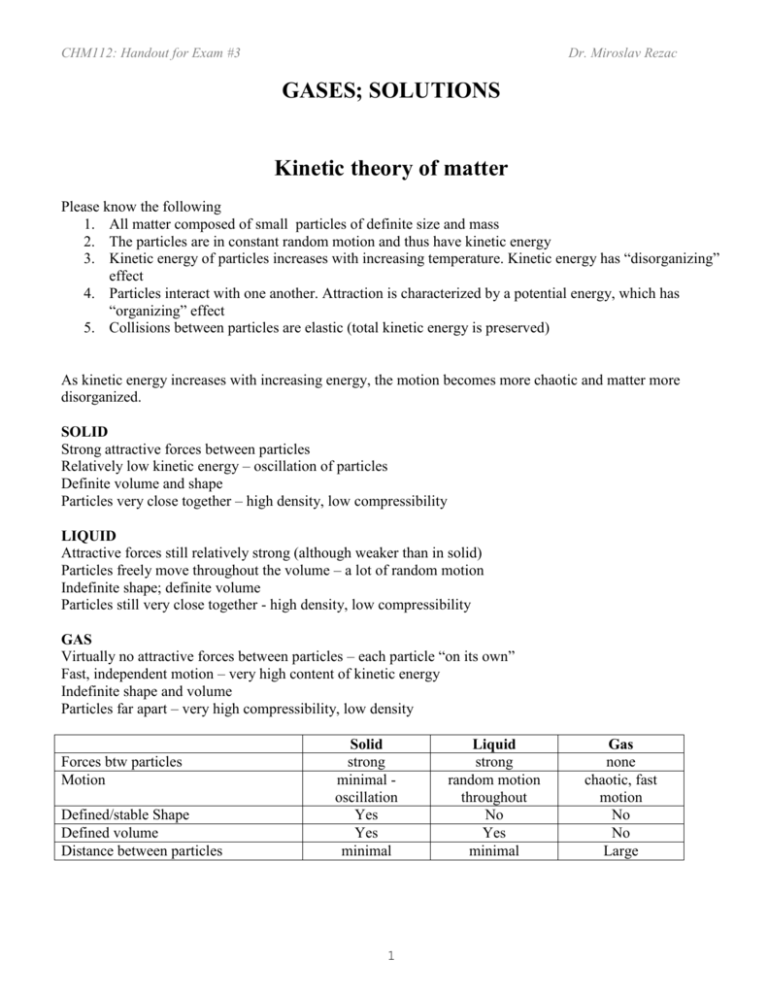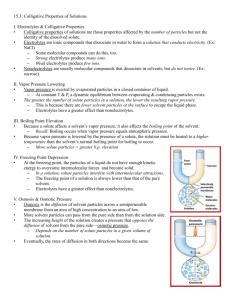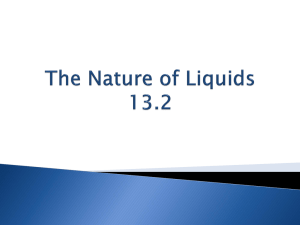Kinetic theory of matter
advertisement

CHM112: Handout for Exam #3 Dr. Miroslav Rezac GASES; SOLUTIONS Kinetic theory of matter Please know the following 1. All matter composed of small particles of definite size and mass 2. The particles are in constant random motion and thus have kinetic energy 3. Kinetic energy of particles increases with increasing temperature. Kinetic energy has “disorganizing” effect 4. Particles interact with one another. Attraction is characterized by a potential energy, which has “organizing” effect 5. Collisions between particles are elastic (total kinetic energy is preserved) As kinetic energy increases with increasing energy, the motion becomes more chaotic and matter more disorganized. SOLID Strong attractive forces between particles Relatively low kinetic energy – oscillation of particles Definite volume and shape Particles very close together – high density, low compressibility LIQUID Attractive forces still relatively strong (although weaker than in solid) Particles freely move throughout the volume – a lot of random motion Indefinite shape; definite volume Particles still very close together - high density, low compressibility GAS Virtually no attractive forces between particles – each particle “on its own” Fast, independent motion – very high content of kinetic energy Indefinite shape and volume Particles far apart – very high compressibility, low density Forces btw particles Motion Defined/stable Shape Defined volume Distance between particles Solid strong minimal oscillation Yes Yes minimal 1 Liquid strong random motion throughout No Yes minimal Gas none chaotic, fast motion No No Large CHM112: Handout for Exam #3 Dr. Miroslav Rezac GAS LAW VARIABLES We already know: Temperature – T (always in Kelvin), Volume - V, Number of moles – n New one: Pressure – p Pressure can be understood as a force exerted against a unit area. Pressure in the gas is the result of impact of particles on the walls of the container. The more numerous and the higher the speed of impacts the higher the pressure: thus, gas confined into a smaller volume (more numerous) or at higher temperature (higher speed) exerts higher pressure. SI unit for pressure is 1 Pascal (Pa). Other units is an atmosphere (~105 Pa), and millimeter of mercury (mm Hg), which is identical to a torr. COMBINED GAS LAW The law used whenever the same body of gas (i.e. the same amount without any leaks or additions!!!) is moved from one situation to another: for example warming up the air inside your car tire. This law takes any one unit of pressure and volume: for example, both volumes can be either in gallons or both in liters, but not one volume in gallons and the second in liters. However, temperature must be in kelvins!!! combined gas law V1 T1 = V2 T2 p constant p1*V1 T1 = p2*V2 T2 V constant p1 T1 = p2 T2 Guy-Lussac Law Charles's Law T constant p1*V1 = p2*V2 Boyle Law Example 1: Party balloon filled with helium at T = 25 normal pressure p = 100,000 Pa and having a volume of 2 liters. Balloon rises to 10,000 ft where temperature is –20 degrees of Celsius, pressure p=35,000 Pa. What would be the volume? Show solution. 1. Remind to convert Celsius to Kelvin first 2. Draw a little cartoon outlining the situation 3. For both situations list known variables and identify unknown 4. Ground high altitude P = 100,000Pa p=35,000Pa V= 2L V=x T=298K T=253K 5. Remind that keeping your solution well organized prevents errors 2 CHM112: Handout for Exam #3 Dr. Miroslav Rezac 6. Plug values into the combined gas law "high up" "ground" p1*V1 T1 = 100,000*2 298 = p2*V2 T2 35,000 * X 253 7. Calculate as much as you can on either side – multiply, divide – it greatly simplifies the equation 671.14 = 138.34 * X 8. In this form it is easy to calculate X by dividing the two numbers X = 671.34 / 138.34 = 4.85 Liters Example 2: Syringe is filled with 100mL air under pressure 100,000 Pa. Then the opening is closed with thumb and plunger moved to 60mL mark. What is the pressure inside? 1. Remind to convert Celsius to Kelvin first 2. Rather than drawing, perform the experiment with 100mL syringe 3. For both situations list known variables and identify unknown 4. “relaxed” P = 100,000Pa V= 100mL “compressed” p=X V=60mL 5. Point out that temperature is not mentioned and is constant – experiment performed in the same room within seconds 6. Thus, simplified version of gas law is to be used 7. Plug values into the combined gas law and solve "compressed" "relaxed" p2*V2 p1*V1 = 100,000*100 = X * 60 10,000,000 = X * 60 X = 10,000,000 / 60 = 166,667 Pa 3 CHM112: Handout for Exam #3 Dr. Miroslav Rezac IDEAL GAS LAW Ideal gas law is the most universal formula, linking together all gas law variables: p*V = n*R*T Where R is the “universal gas constant”. Its value depends only on your choice of units; once you chose units its value is independent of which gas you are working with! for V in m3, p in Pa, T in K, n in mol: R = 8.3 J*mol-1*K-1 Example 1: Weather balloon is filled with helium at T = 25 normal pressure p = 100,000 Pa. The balloon has volume V = 2 m3. Point out that this is a sphere around 5 feet in diameter. 1. Remind to convert Celsius to Kelvin first 2. List known variables and identify unknown p = 100,000Pa T = 298 K n=X V = 2 m3 3. Remind that keeping your solution well organized prevents errors 4. Plug values into the ideal gas law, solve each side and calculate X: p*V = n* R*T 100,000*2 = X*8*298 200,000 = X * 2384 X = 200,000 / 2384 = 83.7 mole 9. Last step is conversion of moles to grams using molar mass (MW). for helium MW = 4 g/mol m = n * MW m = 83.7 * 4 = 335.6 g 10. Point out that the helium inside this balloon weighs ¾ lb, yet the balloon will rise – mention Archimedes law. Example 2: Vial of volume V=100mL is filled with 2.00 g of liquid chloroform. The vial is sealed and heated to 220 degrees of Celsius in a sterilization unit. At this temperature, all chloroform evaporates. What will be pressure in the vial? 1.Convert into proper units Kelvin, m3 2. Calculate n which corresponds to 2.00g of chloroform: MW for chloroform is 119 g/mol 4 CHM112: Handout for Exam #3 Dr. Miroslav Rezac n = m / MW = 2.00 / 119 = 0.0168 moles 3.List known variables and identify unknown T= 493 K V = 1.0*10-4 m3 p=X n = 0.0168 moles 4.Plug into ideal gas law: p*V = n* R*T X* 1.00*10-4 = 0.0168*8*493 X* 1.00*10-4 = 66.26 X = 66.26 / 1.00*10-4 = 662,600 Pa 5.Call attention to the value of pressure: it is 6 times the normal atmospheric pressure and if the vial were made of glass, it would have exploded – point out practical use of the law. DALTON LAW OF PARTIAL PRESSURES This law states that partial pressure of each gas in mixture is equal to pressure the gas would have if it occupied the given volume alone. Sum of all partial pressures is the total pressure. If we know the molar fraction of the gas in question (= # of moles of this gas: total # of moles of all gasses in mixture) we can calculate its partial pressure from total pressure. p = p1 + p2 + p3 etc. p1 = p * (# of moles / total # of moles) p1*V = n1*R*T CHANGES OF STATES GAS condensation deposition sublimation evaporation SOLID melting freezing 5 LIQUID CHM112: Handout for Exam #3 Dr. Miroslav Rezac All changes where matter changes from more organized state (less kinetic energy) to less organized (higher kinetic energy) require a heat energy be supplied from the environment: they absorb energy (above written in bold). This is the case with melting, evaporation, and sublimation. All changes, where matter is increasing its order, going from a state of high kinetic energy to a state with lower kinetic energy, will release heat to the environment: condensation, deposition, freezing (italics). EVAPORATION So, if some molecules of liquid have energy more suited for a gas, it should not come as a surprise that these molecules will tend to “fly away” from the surface of the liquid and become gas, or, a “vapor”. Since at higher temperature we have more of these high-energy molecules present in liquid, evaporation will be faster at higher temperatures. no vapor maximum pressure of vapor some vapor A B C Let us assume you partially fill a container with a liquid and seal it (case A, picture above). As the liquid sits, evaporation occurs, amount of liquid shrinks, amount of vapor grows and thus the partial pressure of vapor is increasing (B). Obviously, the more vapor you have, the higher chance that some of its molecules will “slow down” to kinetic energy range more proper for a liquid, and will tend to return back to the liquid bulk. After some time, this “return” process will be happening as frequently as the “fast” molecules jumping out of the liquid. In other words, in any given time, the same number of molecules leaves the liquid, as returns back into it. Result? The amount of liquid and vapor pressure will not change any further (C). We say that a “dynamic equilibrium” has been reached. From outside, nothing is happening. But if you “tag” all the molecules and look at the system under a “microscope” you would see that individual molecules jump back and forth between gas and liquid. SAME VAPOR PRESSURE! As long as, when equilibrium is reached, there is at least a drop of liquid left, all three containers will have the same vapor pressure!!! A B C D 6 CHM112: Handout for Exam #3 Dr. Miroslav Rezac For any given liquid, vapor pressure depends only on temperature. It is independent of the shape of the container, the amount of liquid you begin with, or the amount of liquid left after you reach equilibrium (as long as there is at least a droplet of liquid left!). The vapor pressure even does not depend on whether there is any air left in the container or whether you squirt the liquid into an evacuated container… BOILING Boiling is a special type of evaporation. It occurs when the vapor pressure equals to the external pressure. So, for a boiling pot of water, you can bet that the vapor pressure of water at the temperature of boiling equals to the current atmospheric pressure! If the external pressure is smaller, for example as a result of altitude, for your open boiling pot, the boiling point is reached at different temperature. For any given liquid, its boiling point depends on external pressure. So, while water has the same vapor pressure at 60 deg. C both in Chicago and on top of Mt. Everest, it will have different boiling points in both locations! Also, weather caused variations of atmospheric pressure cause boiling point to move a bit. In your home, boiling point of water may vary about +/- 2 degrees C. As a rule, lowering external (atmospheric) pressure will lower boiling point. Increasing pressure will increase boiling point (pressure cookers boil at about 110 deg.C; nuclear reactors use liquid water at 300 deg. C – obviously, the pressure must be formidable!). INTERMOLECULAR FORCES DIPOLE-DIPOLE INTERACTION Whenever there is a polar bond present, in such a molecule there is a miniature positive charge, and miniature negative charge. Since + and – attract, the charged ends will interact with other molecules in the vicinity and they will be “held” together, however weak that “glue” may be. As a result, the more tightly molecules are held together, the harder it will be for them to separate – that is what happens upon evaporation. This simple idea explains experimental observation that polar compounds have higher boiling point. In the example above, both compounds contain the same bonds, only C-Cl bonds are polar. Due to unique geometric arrangement, in the compound on right the polarity “cancels” as the arrows have the same size and point in opposite directions. As a result, the molecule on the right is non-polar, molecule on the left is polar: can you explain the difference in boiling points? 7 CHM112: Handout for Exam #3 Dr. Miroslav Rezac HYDROGEN BOND Hydrogen bonds are a unique, super-strong case of dipole interactions. The bond is worth about 1/10 of a covalent bond (which is reeely strong!). It occurs between an H atom attached to N, O, F and a lone electron pair on N, O, F. Hydrogen has only one electron total. So if a polar bond “siphons” away the electron from the bond, the hydrogen nucleus is bare and exposed on the outer side and its positive charge is unshielded by any electrons (for H does not have any more!!). This center of positive charge can interact with a lone electron pair, a space “loaded” with electrons and therefore with a negative charge… H H H non polar bond F H H F unobstructed positive nucleus of H can interact with a lone electron pair polar bond "bares" the hydrogen nucleus hydrogen nucleus F electronegative nucleus of N, O, F lone electron pair bonding orbital In a non-polar bond the nucleus of hydrogen is “buried” within the bonding orbital. When bound to an electronegative atom, such as F, the bonding orbital becomes distorted and “siphoned” away from hydrogen. Such and exposed nucleus can form a hydrogen bond with a lone electron pair within another molecule of HF. LONDON FORCES London forces are the result deformation of electron clouds of atoms. While averaged over a long time the cloud will form a perfect sphere with its center at the nucleus, snapshot at any given time would reveal the cloud being not a sphere and having its center all over. As a result, for a short time, even a completely neutral molecule will form a miniature dipole. "SNAPSHOT" TIME AVERAGED PICTURE + center of negative charge center of positive charge (nucleus) center of negative charge center of positive charge (nucleus) London forces are the only one present for non-polar molecules. Their magnitude is increasing with increasing size of the molecule. In the series of F2, Cl2, Br2 and I2 the magnitude of the London forces 8 CHM112: Handout for Exam #3 Dr. Miroslav Rezac increases from F2 to I2, thereby explaining the increasing boiling points (-188, -35, 59 and 184 oC, respectively). In real life, dipole-dipole interactions and London forces are present together and often are referred to as van der Waals interactions. Careful analysis of intermolecular forces present will allow you to rank similar substances by their boiling points. By similar I mean it possible to compare boiling point of H-F and H-Cl but not of H-Br and H2O… Rule of thumb is, hydrogen bonds always win. When only van der Waals interactions are present, the bigger the formula mass, the higher the boiling point. Example: Solution: Answer: Reality: Rank H-F, H-Cl, H-Br, H-I from highest boiling point to lowest. You find that H-F is capable of hydrogen bonding. That’s winner. With the rest, follow decreasing formula mass. H-F > H-I > H-Br > H-Cl 20, -35, -69 and –85 oC, respectively SOLUTIONS Solution: Therefore: Homogeneous mixture Properties uniform throughout Solvent and solutes can be separated by physical means One substance is usually in excess and is called solvent. Minority components are called solutes. TYPES OF SOLUTIONS: Liquid: - gas dissolved in liquid (soda before bottle opened) - sugar dissolved in water Gas - oxygen dissolved in nitrogen (air) Solid - alloy: 14K gold is copper dissolved in gold SOLUBILITY: maximum amount of solute defined amount of solvent can hold (usually increases with temperature). SATURATED SOLUTION: maximum amount of solute dissolved: solubility limit reached. Usually there are leftovers of undisolved solute present. No visible change, however, molecules of solute moving back and forth between the undissolved solute and solution (there goes that dynamic equilibrium again!!). 9 CHM112: Handout for Exam #3 Dr. Miroslav Rezac Formation of solutions Let us imagine we are dissolving table salt in water. We know that table salt (NaCl) is formed of ions and ions of opposite charge will stick together very well (NaCl is solid, hard to melt, impossible to evaporate!). In water, on the other end, molecules are engaged in hydrogen bonds. Thus, to dissolve salt in water would mean to disrupt both of these forces. What is then the driving force “dragging” salt into water? Obviously, the penalty incurred by disrupting attractive forces must be offset by something even more advantageous. That “something” is called solvation. Solvation is a process where particles of solute (molecules or atoms) form attractive interactions with molecules of solvent. For aqueous solutions (where the solvent is water) this means either dipole-dipole or hydrogen bonds. SOLVATION OF POLAR SOLUTES BY WATER solid ionic compound solution water polar molecule molecule of water This simple idea explains why polar compounds are soluble in water (salt or sugar) while non-polar are not (wax, oil or vitamin A). In general, “similar dissolves similar”. Which means that to dissolve a polar substance you need a polar solvent, to dissolve a non-polar substance you need a non-polar solvent (remember the reason why you add oil to your salad?!). Like any other, this rule has some exceptions, and sometimes a substance will not be soluble in anything, period, end of story. However, that is what makes life interesting, isn’t it? If everything could be predicted a priori then what would we do with our lives after the first grade? Warning: ionic compounds will “fall apart” into its constituent ions upon dissolving (provided they are soluble at all…). CONCENTRATION Concentration tells us how much solute is present in solution. There are several ways to express concentration, we’ll cover only 2. Yeeeees!!! 10 CHM112: Handout for Exam #3 Dr. Miroslav Rezac 1) Mass % Mass percent tells us how many grams of solute are contained in 100g of solution. The only caveat is to remember that both the solvent and the solute contribute to the mass of the solution. Example: What is % concentration of solution you get when you dissolve 5g NaCl in 40g of water? First, figure the total mass of solution. m(solution) = m(solute) + m(solvent) m(solution) = 5 + 40 = 45g %= m (solute) m (solution) *100% = 11.1% 2) Molarity Molarity tells us the number of moles in 1L of solution (in most of cases we can consider this to be 1L or solvent). We calculate the number of moles and divide it by the volume of solution we prepare (in liters). The unit of molarity is 1 mol.dm-3, often abbreviated as “1M”. Example: Calculate the molarity of solution prepared by dissolving 4g of NaOH in 250ml of water. First, calculate the # of moles of NaOH: 4g NaOH = 4/(23+16+1) = 4/40 = 0.1 mol NaOH Second: concentration = 0.1mol/0.25L = 0.4 mol.dm-3 = 0.4M COLLOIDAL DISPERSIONS Sometimes also called “colloidal solutions” – which is correct and wrong at the same time… Chemists really haven’t agreed to what exactly is a colloidal dispersion… Let us just agree upon that it is a dispersion in a solvent of particles which: - are too small to be seen by naked eye - do not settle to the bottom by gravity - cannot be filtered out using a filter paper - (probably most important) they scatter light - about 1000 times larger than well-behaved molecules (sugar) COLLIGATIVE PROPERTIES OF SOLUTIONS In essence, the effect of presence of solute on certain properties like freezing point, boiling point etc. The magnitude of these effects depends only on the concentration of particles in a solvent, and not upon the kind of particles! The three most common effects are: 11 CHM112: Handout for Exam #3 - Dr. Miroslav Rezac decrease of vapor pressure (= increase of boiling point) decrease of melting point osmotic pressure The magnitude of the above will be the same for 1M solution of sugar or 1M solution of ethylene glycol (antifreeze) regardless the difference in the solute… The first two effects are nicely demonstrated by antifreeze: not only addition of ethylene glycol to water decreases its freezing point, it also increases the boiling point! As the vapor pressure of water decreases as a result of presence of solute, it will have to be heated to a higher temperature than normal boiling point, for the vapor pressure to “catch up” to the atmospheric pressure. As we know, boiling point is temperature where the vapor pressure of a liquid equals the atmospheric pressure? CAVEAT: Please keep in mind that some substances will trick you. If you dissolve 1 mol of NaCl in 1L of water, once dissolved, the Na+ and Cl- will float around independent of each other. So will the actual particle concentration be 1M or 2M? Answer: 2M, you will have 1M Na+ and 1M Cl-!!! OSMOSIS Osmosis is the tendency of a solvent to flow into area of higher solute concentration. Obviously, if there is no barrier present, mixing will quickly abolish areas of higher and lower concentration. However, if you have two compartments separated by a membrane, which will let solvent pass through, and nothing else, then you will see that: solvent will be seeping into the compartment with higher solute concentration. This flow can be stopped by pressure, hence the term “osmotic pressure”. The chapter 8.8 explains things really well. Just to make it easier, don’t worry about the term “osmolarity”. Just remember that like any other colligative property, osmotic pressure is governed by the total concentration of particles, not by the formal concentration of the substance: 1M solution of sugar: 1M solution of Na2SO4: behaves as 1M behaves as (2*1M Na+ + 1*1M SO42-) = 3M So, you see that while all 1M solutions were created equal, some of them are more equal than others!!! 12









